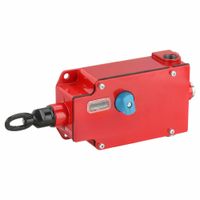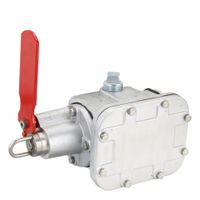Call +(254) 703 030 000 / 751 483 999 / 721 704 777
- Home
- Electrical
- Industrial Controls Automation And Machine Safety
- Machine Safety
- Cable Pull Switches
.....Read More
Frequently Asked Questions
What is a cable pull switch and how does it work?
A cable pull switch, also known as a pull cord switch or emergency stop switch, is a safety device used in industrial settings to provide a quick and accessible means of stopping machinery or equipment in an emergency. It is typically installed along conveyor belts or other machinery where immediate shutdown is necessary to prevent accidents or injuries.
The switch consists of a cable or cord that runs along the length of the equipment. This cable is connected to a switch mechanism that is mounted at a fixed point. When the cable is pulled, it activates the switch, which sends a signal to stop the machinery. The switch can be either mechanical or electronic, depending on the design and application.
The cable pull switch operates on a simple principle: tension in the cable triggers the switch. The cable is kept under slight tension, and pulling it increases the tension, causing the switch to activate. This action can be initiated from any point along the cable, providing a versatile and accessible emergency stop mechanism.
In addition to emergency stops, cable pull switches can also be used for routine operations, such as starting or stopping machinery, depending on the configuration. They are designed to be robust and reliable, often featuring weatherproof and dustproof enclosures to withstand harsh industrial environments.
Overall, cable pull switches are crucial for enhancing workplace safety by allowing workers to quickly and effectively halt machinery in case of an emergency, thereby reducing the risk of accidents and injuries.
How do you install a cable pull switch on a conveyor system?
1. **Preparation**: Ensure the conveyor system is powered off and locked out for safety. Gather necessary tools and equipment, including the cable pull switch, mounting brackets, cable, tension springs, and a tensioner.
2. **Positioning**: Determine the optimal location for the cable pull switch. It should be accessible and cover the entire length of the conveyor where emergency stopping is required.
3. **Mounting the Switch**: Securely mount the cable pull switch to the conveyor frame using the provided brackets. Ensure it is positioned so that the pull cable can run parallel to the conveyor.
4. **Installing the Cable**: Attach the cable to the switch. Run the cable along the length of the conveyor, ensuring it is taut and free from obstructions. Use pulleys or guides if necessary to maintain a straight path.
5. **Tensioning**: Install tension springs at the end of the cable opposite the switch. Use a tensioner to adjust the cable to the correct tension as specified by the manufacturer. The cable should be tight enough to prevent sagging but not so tight that it triggers the switch.
6. **Securing the Cable**: Use cable clamps or ties to secure the cable at regular intervals along the conveyor frame. Ensure the cable is not rubbing against any sharp edges or moving parts.
7. **Testing**: Once installed, test the system by pulling the cable at various points to ensure the switch activates and stops the conveyor. Reset the switch after each test to confirm proper operation.
8. **Final Checks**: Inspect the entire installation for any loose components or potential hazards. Ensure all safety covers and guards are replaced.
9. **Documentation**: Record the installation details and any adjustments made for future reference and maintenance.
What are the benefits of using cable pull switches for emergency stop applications?
Cable pull switches offer several benefits for emergency stop applications:
1. **Extended Reach**: Cable pull switches can cover long distances, making them ideal for large machinery or conveyor systems where multiple access points are necessary.
2. **Continuous Access**: They provide continuous access along the length of the cable, allowing operators to trigger an emergency stop from any point along the cable, enhancing safety and response time.
3. **Versatility**: Suitable for various environments, including harsh industrial settings, cable pull switches can be used in diverse applications, from manufacturing to material handling.
4. **Cost-Effective**: By covering extensive areas with a single system, they reduce the need for multiple individual switches, lowering installation and maintenance costs.
5. **Simplicity**: The straightforward design of cable pull systems makes them easy to install and operate, requiring minimal training for effective use.
6. **Durability**: Built to withstand tough conditions, these switches are often resistant to dust, moisture, and mechanical wear, ensuring reliable performance over time.
7. **Quick Reset**: Many cable pull switches feature easy reset mechanisms, allowing for rapid resumption of operations after an emergency stop, minimizing downtime.
8. **Compliance**: They help meet safety regulations and standards by providing a reliable means of stopping machinery in emergencies, contributing to a safer workplace.
9. **Visibility**: The cable is often brightly colored, making it easily visible and accessible, which is crucial in emergency situations.
10. **Flexibility**: They can be integrated into existing systems without significant modifications, offering flexibility in design and application.
Overall, cable pull switches enhance safety, efficiency, and cost-effectiveness in emergency stop applications.
How do you maintain and test cable pull switches to ensure they function properly?
1. **Visual Inspection**: Regularly check the cable pull switch and its components for signs of wear, corrosion, or damage. Ensure the cable is taut and free from obstructions.
2. **Tension Adjustment**: Verify that the cable tension is within the manufacturer's specified range. Adjust the tension using the tensioning device to ensure the cable is neither too loose nor too tight.
3. **Functional Testing**: Conduct periodic tests by manually pulling the cable to activate the switch. Confirm that the switch triggers the intended response, such as stopping machinery or sounding an alarm.
4. **Switch Reset**: After testing, reset the switch according to the manufacturer's instructions. Ensure the switch returns to its normal operating position and the system is ready for use.
5. **Electrical Testing**: Use a multimeter to check the electrical continuity of the switch. Ensure that the switch opens and closes the circuit as expected when activated.
6. **Lubrication**: Apply appropriate lubricants to moving parts, if recommended by the manufacturer, to prevent rust and ensure smooth operation.
7. **Documentation**: Keep detailed records of inspections, tests, and maintenance activities. Note any issues found and corrective actions taken.
8. **Training**: Ensure personnel are trained in the operation and testing of cable pull switches. They should know how to identify issues and perform basic maintenance.
9. **Compliance Check**: Ensure that the cable pull switch system complies with relevant safety standards and regulations.
10. **Replacement**: Replace any worn or damaged components immediately to maintain system integrity and safety.
By following these steps, you can ensure that cable pull switches function properly and maintain safety in their operational environment.
What are the differences between cable pull switches for dry and wet environments?
Cable pull switches for dry and wet environments differ primarily in their design, materials, and sealing to accommodate the specific conditions they will face.
1. **Material and Coating**:
- **Dry Environment**: These switches may use standard materials without special coatings, as they are not exposed to moisture.
- **Wet Environment**: These switches often use corrosion-resistant materials like stainless steel or have protective coatings to prevent rust and degradation.
2. **Sealing and Enclosure**:
- **Dry Environment**: The sealing may be minimal, focusing on dust protection rather than moisture.
- **Wet Environment**: These switches have robust sealing, often rated with IP (Ingress Protection) ratings like IP67 or IP68, to ensure water and dust resistance.
3. **Design and Construction**:
- **Dry Environment**: The design may be simpler, focusing on basic functionality without additional protective features.
- **Wet Environment**: The design includes features like gaskets, O-rings, and sealed enclosures to prevent water ingress.
4. **Temperature and Humidity Tolerance**:
- **Dry Environment**: These switches are designed for stable temperature and humidity conditions.
- **Wet Environment**: They are built to withstand fluctuating temperatures and high humidity, often with enhanced thermal management.
5. **Maintenance and Durability**:
- **Dry Environment**: Maintenance may be less frequent due to the absence of moisture-related issues.
- **Wet Environment**: These switches require materials and designs that ensure long-term durability despite constant exposure to moisture.
6. **Compliance and Standards**:
- **Dry Environment**: Compliance with basic safety standards.
- **Wet Environment**: Must meet stringent standards for water resistance, such as NEMA or IP ratings.
These differences ensure that cable pull switches function reliably in their respective environments, maintaining safety and operational efficiency.
How do cable pull switches for hazardous locations differ from standard ones?
Cable pull switches for hazardous locations differ from standard ones primarily in their design, construction, and certification to ensure safety in environments with explosive gases, dust, or other hazardous materials.
1. **Material and Construction**: Hazardous location switches are made from robust materials like stainless steel or aluminum to withstand harsh conditions and prevent sparking. They often have sealed enclosures to prevent the ingress of dust, gas, or moisture.
2. **Explosion-Proof Design**: These switches are designed to contain any explosion within the device, preventing it from igniting the surrounding atmosphere. They have flameproof enclosures and are built to withstand internal explosions without transmitting the explosion to the external environment.
3. **Certification and Compliance**: They must meet stringent international standards and certifications such as ATEX, IECEx, or UL for use in hazardous areas. These certifications ensure that the switches are tested and approved for safety in specific hazardous conditions.
4. **Temperature Ratings**: They are designed to operate safely within a specific temperature range to prevent overheating, which could ignite hazardous materials.
5. **Corrosion Resistance**: Given the environments they are used in, these switches often have enhanced corrosion resistance to withstand chemicals and other corrosive substances.
6. **Sealing and Protection**: They feature enhanced sealing to protect internal components from dust, water, and other contaminants, often achieving high IP ratings.
7. **Durability and Reliability**: Built for high reliability, they are designed to function effectively over long periods without failure, even in extreme conditions.
8. **Installation and Maintenance**: They often require specialized installation and maintenance procedures to ensure continued safety and compliance with regulations.
These differences ensure that cable pull switches for hazardous locations can operate safely and effectively in environments where standard switches would pose a risk.
What are the common troubleshooting steps for cable pull switch malfunctions?
1. **Visual Inspection**: Check for visible damage or wear on the cable, switch, and mounting hardware. Ensure the cable is properly tensioned and not frayed or broken.
2. **Check Connections**: Verify that all electrical connections are secure and free from corrosion. Tighten any loose connections and clean any corroded terminals.
3. **Test the Switch**: Manually activate the switch to ensure it is functioning correctly. Listen for any unusual sounds or resistance that may indicate a mechanical issue.
4. **Inspect the Cable Path**: Ensure the cable is running smoothly along its path without any obstructions or sharp bends that could cause it to snag or wear prematurely.
5. **Check Tension**: Ensure the cable tension is set according to the manufacturer's specifications. Adjust the tension if necessary to ensure proper operation.
6. **Examine the Actuator**: Inspect the actuator mechanism for any signs of wear or damage. Replace any worn or damaged components.
7. **Test Electrical Continuity**: Use a multimeter to check for electrical continuity in the switch circuit. Ensure there are no breaks in the wiring.
8. **Check for Environmental Factors**: Ensure the switch and cable are not exposed to extreme temperatures, moisture, or chemicals that could affect their performance.
9. **Review Installation**: Confirm that the switch and cable are installed according to the manufacturer's guidelines. Incorrect installation can lead to malfunctions.
10. **Consult Documentation**: Refer to the manufacturer's troubleshooting guide for specific issues related to the model in use.
11. **Replace Components**: If troubleshooting does not resolve the issue, consider replacing the switch or cable with new components.
12. **Professional Assistance**: If the problem persists, seek help from a qualified technician or the manufacturer’s support team.


